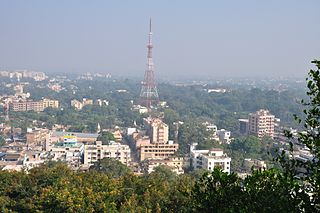
Jharkhand is a state in eastern India. The state shares its border with the states of West Bengal to the east, Chhattisgarh to the west, Uttar Pradesh to the northwest, Bihar to the north and Odisha to the south. It has an area of 79,716 km2 (30,779 sq mi). It is the 15th largest state by area, and the 14th largest by population. Hindi is the official language of the state. The city of Ranchi is its capital and Dumka its sub-capital. The state is known for its waterfalls, hills and holy places; Baidyanath Dham, Parasnath, Dewri and Rajrappa are major religious sites. The state was formed in 2000, from the territory that had previously been part of Bihar.

Ranchi is the capital of the Indian state of Jharkhand. Ranchi was the centre of the Jharkhand movement, which called for a separate state for the tribal regions of South Bihar, northern Orissa, western West Bengal and the eastern area of what is present-day Chhattisgarh. The Jharkhand state was formed on 15 November 2000 by carving out the Bihar divisions of Chota Nagpur and Santhal Parganas. Ranchi has been selected as one of the hundred Indian cities to be developed as a smart city under PM Narendra Modi's flagship Smart Cities Mission.

Magadha was a region and one of the sixteen Mahajanapadas, 'Great Kingdoms' of the Second Urbanization in what is now south Bihar at the eastern Ganges Plain. Magadha was ruled by Brihadratha dynasty, Pradyota dynasty, Haryanka dynasty, and the Shaishunaga dynasty. Villages had their own assemblies under their local chiefs called Gramakas. Their administrations were divided into executive, judicial, and military functions.
Gumla is a city which is the district headquarters in the Gumla subdivision of the Gumla district in the state of Jharkhand, India.

The Kurukh or Oraon or Dhangar, also spelt Uraon or Oraon, are a Dravidian ethnic group inhabiting the Indian states of Jharkhand, West Bengal, Odisha and Chhattisgarh. They predominantly speak Kurukh as their native language, which belongs to the Dravidian language family. In Maharashtra, Oraon people are also known as Dhangad or Dhangar.

Ranchi district is the most populous district of Jharkhand state in eastern India. Ranchi, the capital of Jharkhand, is the district headquarters. It was established as a district in 1899.

Sadri is an Indo-Aryan language spoken in the Indian states of Jharkhand, Chhattisgarh, Odisha and Bihar. It is native language of the Sadan. In addition to native speakers, it is also used as lingua franca by many tribal groups such as Kharia, Munda and Kurukh, and a number of speakers of these tribal groups have adopted it as their first language. It is also used as a lingua franca among Tea-garden community of Assam, West Bengal and Bangladesh. According to the 2011 Census, there were approximately 5,130,000 native speakers of the Nagpuri language, including 19,100 identifying as Gawari, 4,350,000 as "Sadan/Sadri" and 763,000 as "Nagpuria". Around 7 million people speak it as second language.
The region have been inhabited since the Stone Age. Copper tools from the Chalcolithic period have been discovered. This area entered the Iron Age during the mid-2nd millennium BCE.
Chik Baraik is a community found in Indian State of Jharkhand, Chhattisgarh, Odisha. They were traditionally Weaver.
Ranchi district is one among the twenty-four districts of the state of Jharkhand in Eastern India. This region was under the control of the Magadha Empire, then it was a part of the Mauryan Empire under Ashoka and later a part of the Gupta Empire. After the fall of the Gupta Empire a legendary king named Phanimukut established the Nagvanshi dynasty and controlled the Chota Nagpur plateau region for several centuries thereafter.
Kulamara is a revenue village located in Simdega district of the Indian state of Jharkhand. The village is located in Targa Panchayat. Kulamara is situated in Bansjore block. It is one of 19 villages in Bansjore Block.

The Nagvanshis of Chotanagpur, was an ancient Indian dynasty which ruled the parts of Chota Nagpur plateau region during much of ancient, medieval and modern period. Phani Mukut Rai is considered the first king of dynasty claim to be Son of Pundrika Naga a mythical Naga. Lal Chintamani Sharan Nath Shahdeo (1931–2014) was last ruling king of the dynasty, until the estate was merged to the Republic of India.
The Indian state of Jharkhand is located in the eastern part of the country and is known for its vivid culture,distinct paintings, traditions and festivals.
Nagpuri cinema refers to films produced in the Nagpuri language in state of Jharkhand.

Mukund Nayak, is an Indian artist. He is a folk singer, songwriter and dancer. Nayak is an exponent of Nagpuri folk dance Jhumar. He is recipient of the Padma Shri and Sangeet Natak Akademi Award.
Sadan are the Indo-Aryan-speaking ethnolinguistic groups of Chota Nagpur Plateau consist of Indian state of Jharkhand and neighbouring states who speak Nagpuri, Khortha, Panchpargania and Kurmali language as their native language.
Pandey Ganpat Rai (1809-1858) was a revolutionary and rebel leader in the Indian Rebellion of 1857 and a chieftain in Lohardaga district of Bihar.
Lal Ranvijay Nath Shahdeo, was a lawyer, poet, writer and political activist. He was one of the prominent leader of movement for separate Jharkhand state. He had written several Nagpuri poem, songs and slogans for Jharkhand movement. He changed the state name Vananchal to Jharkhand by a debate with Prime minister Atal Bihari Vajpayee. He was recipient of the Jharkhand Ratna Award for his contribution in movement for separate state of Jharkhand.
Udai Pratap Nath Shahdeo KIH, was the Nagvanshi Maharaja of Chotanagpur Zamindari estate. He built the Ratu Palace in Ranchi in 1901. He was conferred the Kaiser-i-Hind Medal for public services.










